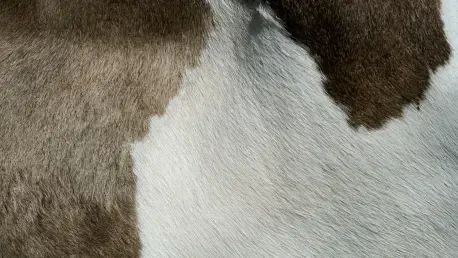In the ever-evolving world of interior design, patterns and prints come and go, each bringing its own special flavor to the spaces people inhabit. For decades, animal prints have occupied a prominent role, adding flair and character to homes. Traditionally, leopard print has been a fan favorite, epitomizing boldness, luxury, and a touch of rebellion. Yet, a new contender has quietly entered the scene and is challenging the reign of the leopard: cow print. This article explores the surprising emergence of cow print as a trendy and highly sought-after pattern in the realm of interior design, examining its rise in popularity and how it is seamlessly integrated into contemporary settings.
The Historical Reign of Animal Prints
Leopard Print: A Long-standing Icon
Leopard print has long stood as the quintessential pattern renowned for its dynamic and glamorous appeal, with an ability to transform any space into a statement-making design. Historically, leopard print’s roots stretch deep into culture and fashion, often associated with luxury, sophistication, and a daring sensibility. Its evergreen allure in interior design has allowed it to remain a staple in a variety of domains, from home decor accents to bold, theatrical upholsteries. The print’s enduring popularity can be attributed to its aesthetically engaging spots that bring energy, mystery, and liveliness into diverse settings, resonating with those who seek an aesthetic escape from the mundane.
Throughout the years, leopard print has become synonymous with individual expression, rebellion against the understated, and an embrace of the exotic. Its luxurious feel, rich in cultural references, continues to capture the imaginations of designers and decorators alike, making it a go-to choice for adding sophistication and vibrancy. From the delicate detailing of a velvet pillow to the sweeping grandeur of patterned drapes, leopard print remains a timeless fixture, proving that its bold and striking design transcends temporality. The intrigue and glamor of leopard are unmatched, underscoring its historical significance as a beloved design icon that embodies a perfect blend of flamboyance and class.
From Wild to Western: The Emergence of Cow Print
Emerging from the shadows of its bolder predecessor, cow print has been subtly redefining its presence in interior design, bringing with it a sense of understated sophistication and natural charm. Initially associated with rustic, Western-style decor, cow print was often relegated to niche settings like barns or cowboy-themed spaces. However, its distinct pattern, characterized by fluid and asymmetrical black or brown patches set against a creamy backdrop, has undergone a transformation, introducing a calming yet stylish sensibility to modern aesthetics. The print evokes a serene, lived-in vibe that resonates deeply with contemporary tastes preferring grounded, organic visuals.
The transition from leopard to cow print signifies a shift in the design narrative towards patterns that balance sophistication with subtlety. Cow print’s integration into various design styles has been buoyed by its versatility and universal appeal, capable of enhancing minimalist spaces as well as eclectic ones. Unlike leopard’s vibrant intensity, cow print introduces a naturalistic element that complements modern interiors’ move towards textures and patterns rooted in nature. As people show increasing interest in connecting with natural aesthetics, cow print emerges as a pattern that captures rustic nostalgia while offering a fresh approach to styling spaces.
Cultural Influences on Design Trends
Cowboy Core and Celebrity Endorsement
As cow print continues to capture the imagination of interior decorators, its rise can be partly attributed to broader cultural movements, particularly the ‘cowboy core’ phenomenon. This trend encapsulates an embrace of Western influences, reflecting a broader desire for authenticity, earthiness, and a return to simpler styles that connect with nature. The aesthetic is defined by its characteristic elements—denim, suede, and rustic leather, underpinned by earthy tones—that find a natural counterpoint in cow print. High-profile celebrities like Taylor Swift and Beyoncé have publicly embraced cowboy core in recent years, further enhancing its reach and acceptance.
This celebrity endorsement, alongside evolving tastes in the fashion industry, has played a pivotal role in catapulting cow print into mainstream consciousness. The confluence of these factors has seen cow print become a symbol of the current zeitgeist, characterized by a preference for eclectic diversity fused with nostalgic accents. This broader acceptance allows homeowners to explore innovative textures and contrasts, making cow print a riveting option that seamlessly introduces both novelty and tradition into spaces. Such cultural connectivity has transformed cow print from an undervalued element into a prestigious design choice that captures the spirit of the times.
Designer Advocacy and Strategy
The widespread acceptance of cow print can also be attributed to pioneering designers who have championed its unique visual appeal and versatility. Abigail Ahern stands out as a prominent advocate, seamlessly weaving cow print into her collections with a keen eye towards illustrating its adaptability across different styles. Ahern’s design ethos embraces ‘happy clashing,’ harmoniously blending unconventional elements that cut through traditional aesthetics and showcase cow print as both an accent and a centerpiece. Her approach articulates how cow print can add polish and edge, engaging modern interiors with its understated elegance.
Ahern’s creative endeavors highlight cow print’s capability to enhance myriad design schemes, from the stark simplicity of minimalism to the richness of eclectic style. By innovatively combining contrasting patterns such as florals and stripes, she demonstrates cow print’s role as a versatile resource. This adaptable quality assures its status as more than a passing trend, highlighting how it aligns with diverse consumer preferences. The strategic use and embrace of cow print by influential designers not only provide an engaging backdrop but also contribute meaningfully to its status as an enduring staple in contemporary design.
Versatility and Adaptation in Modern Spaces
Cow Print Beyond Rustic
Gone are the days when cow print was considered strictly a rustic motif. Its evolution has paved the way for an array of applications across various materials and objects, proving its versatility. Upholstered furniture, cowhide ottomans, lamp bases, even tiles and wallpaper have become canvases for this chic pattern. Cow print characterizes a juxtaposition of rustic allure and modern elegance, effectively breaking free from its Western-themed confines and establishing itself as a sophisticated choice for a myriad of modern settings. This adaptability maintains its relevance across a broad spectrum of interior styles, both traditional and contemporary.
By reimagining cow print’s potential, designers have found inventive ways to integrate the pattern into both subtle and statement pieces. It often manifests in spaces where it serves as a focal point, juxtaposing other design elements with balance and cohesion. The tactile quality and organic composure of cow print elements elevate its appeal, reinforcing its position as a resourceful pattern choice. Whether in maximalist expressions laden with contrasts or tranquil minimalist environments, cow print offers an aesthetic flexibility that resounds with decorators aiming to infuse their spaces with charm while avoiding overpowering visuals.
Harmonizing Patterns and Fabrics
The art of incorporating cow print into interiors lies in its ability to harmonize with various patterns and fabrics, enabling a seamless blend rather than a clashing confrontation. As trends shift towards balancing textured and naturalistic elements, cow print emerges as an ideal candidate for weaving into layered designs. By coupling cow print with other diverse patterns—such as vivid florals, geometric stripes, or classic plaids—interior spaces acquire a rich tapestry of textures and visual excitement that speaks to both cohesiveness and charm. This allows designers to craft bespoke environments that are both functional and aesthetically pleasing.
Harmonizing cow print with traditional and contemporary fabrics enhances its adaptability. For example, placing cow print cushions against a backdrop of neutral tones evokes a sense of calm yet intriguing modernity. Alternatively, pairing it with vintage-inspired textiles can excavate nostalgic warmth in a space. Such versatility enables homeowners to personalize their aesthetics while maintaining a cohesive identity within their interiors. The interplay of contrasting elements continues to prove that cow print’s allure is not merely contained in its novelty but in its enriching capacity to coalesce distinct layers for an engaging and timeless decor narrative.
The Broader Cultural and Aesthetic Impact
A Trend Towards Naturalism and Texture
The emergence of cow print reflects a broader trend in interior design that leans toward naturalism and enriching textures. With cultural influences now emphasizing sustainable, grounded styles, cow print has earned its place as a pattern that embodies these ideals. It extends beyond mere aesthetic appeal, offering a tactile and visual complexity that complements the desire for spaces resonating with nature-inspired elements. Its organic tones and dynamic patterns evoke a connection to rustic environments, capturing the essence of tranquility and simplicity in modern homes.
Designers have increasingly gravitated towards incorporating textures that echo the natural world, and cow print perfectly encapsulates this movement. By providing a conduit for this connection, it enhances interior spaces in a way that feels authentic and grounded yet stylishly curated. The pivot to textures that invite warmth and familiarity has been pivotal in embedding cow print into the cultural consciousness as not just a design statement, but as a celebration of naturalism in crafted environments. This evolution signifies an openness to patterns that convey a narrative of authenticity and visual intrigue.
The Lasting Appeal of Cow Print
In the dynamic world of interior design, styles, patterns, and prints frequently ebb and flow, each introducing a unique personality to the environment people call home. Throughout the years, animal prints have been at the forefront, serving as staples in interior design that add boldness and character. For many, leopard print quickly became a favorite, symbolizing a mix of daring, opulence, and a hint of rebellion. However, recently, a new pattern has emerged, subtly making its mark and potentially dethroning the leopard: cow print. This fresh design choice is rather surprising in its appeal, yet it’s gaining traction among designers and homeowners. Cow print’s distinct look and versatility make it a refreshing choice that seamlessly complements both traditional and contemporary aesthetics. This article delves into cow print’s unexpected popularity in interior design, exploring its rise and how it integrates effortlessly into modern settings, providing a stylish and fresh alternative to more conventional patterns.









